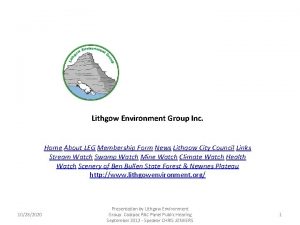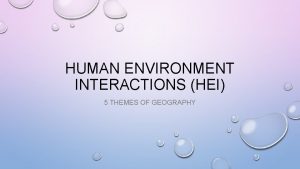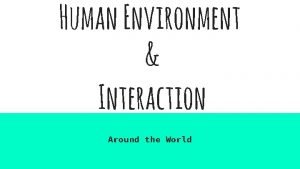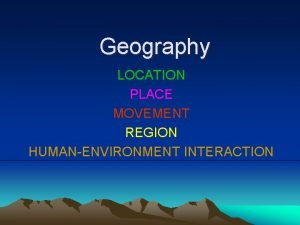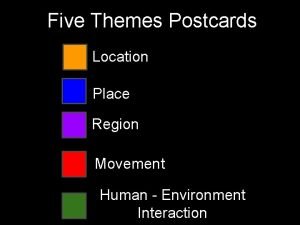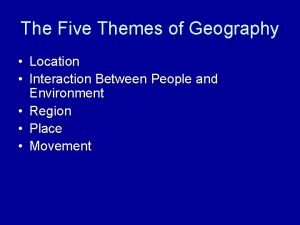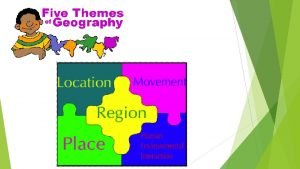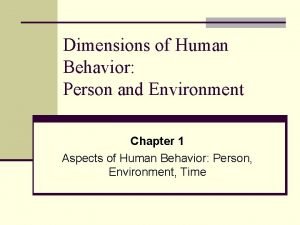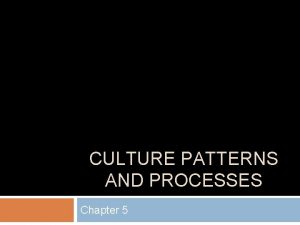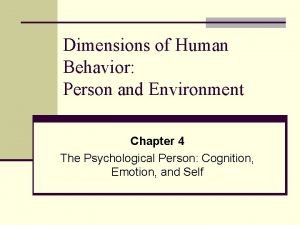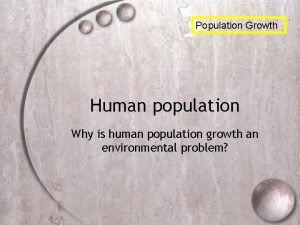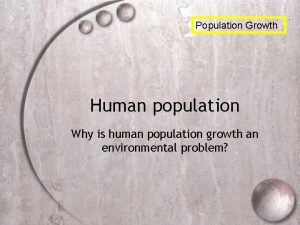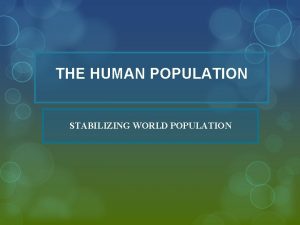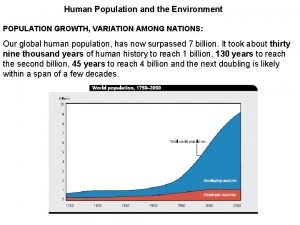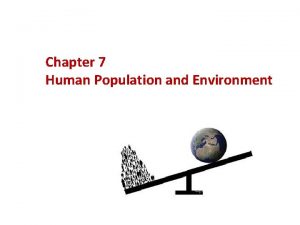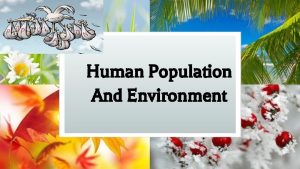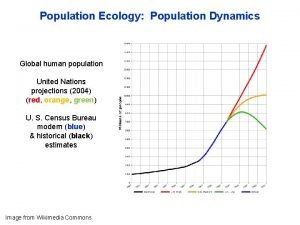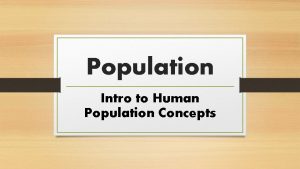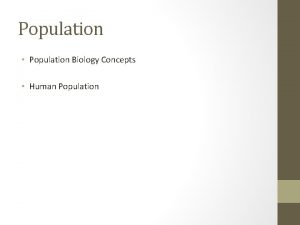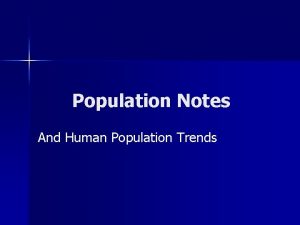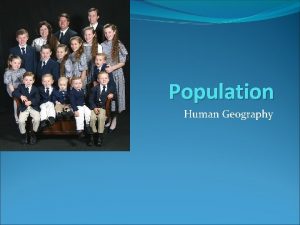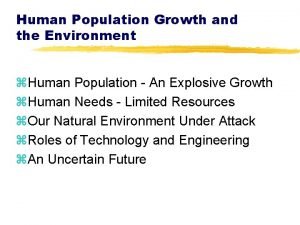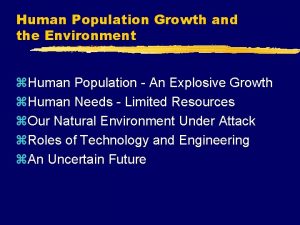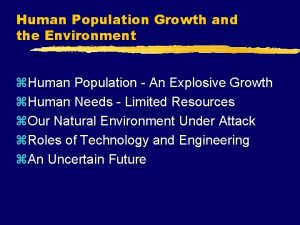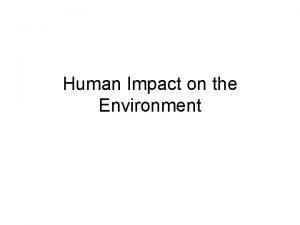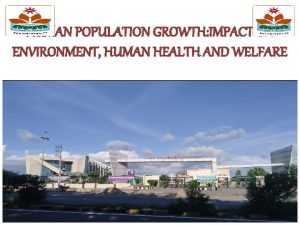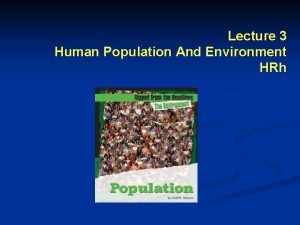Unit 5 HUMAN POPULATION THE ENVIRONMENT POPULATION Group












































- Slides: 44

Unit -5 HUMAN POPULATION & THE ENVIRONMENT

POPULATION • “Group of individuals of species occupying a definite geographic area at a given time. ” POPULATION DENSITY “It is expressed as the number of individuals of the population per unit area or per unit volume. ”

Parameters affecting population size • Birth rate or Natality – It is the number of live birth per 1, 000 people in a population in a given year. • Death rate or Mortality– It is the number of live deaths per 1, 000 people in a population in a given year. • Immigration – It denotes the arrival of individuals from neighbouring population. • Emigration –It denotes the dispersal of individuals from the original population to new areas.

POPULATION GROWTH “The rapid growth of the global population for the past 100 years from the difference between the rate of birth and death. ” Causes: • decrease in death rate and increase in birth rate. • Availability of antibiotics decreases the famine related deaths. • In agricultural based countries, children are required

• • • Characteristics of population growth Exponential growth Doubling time Infant mortality rate Total fertility rate Male/female ratio Demographic transition.

• • • Problems of population growth Increasing demand for food & natural resources Inadequate housing & health services. Loss of agricultural lands Unemployment & socio-political unrest Environmental population

VARIATION OF POPULATION BASED ON AGE STRUCTURE • Pre-productive population (0 -14 years) • Reproductive population (15 – 44 years) • Post reproductive population (above 45 years)

• Pyramid shaped – India, Bangladesh, and Ethiopia. [Large no of young people enter into reproductive age group, hence Population growth increases]. • Bell shaped – France, USA, and UK. [Preproductive age group population & reproductive age group population are almost equal, hence population growth is stable].

Bell & pyramid shaped population structure

• Urn shaped - Germany, Italy, and Japan [preproductive population is less that reproductive age group, hence population growth decreases].

POPULATION EXPLOSION “The enormous increase in population due to low death rate and high birth rate is termed as population explosion. ” Causes : • Modern medical facilities • Increase of life expectancy • Illiteracy.

Effects: • Poverty • Environmental degradation • over - exploitation • Renewable resources like forests are under threat • increase disease • Overcrowding • Lack of basic amenities Remedy • Reducing fertility rate through birth control programmes.

FAMILY WELFARE PROGRAMME § covering human health, maternity, family welfare, child care & women’s right. Objectives • Slowing down the population explosion • Reducing Over exploitation of natural resources Population Stabilization Ratio • Developed Countries: → Stabilization ratio = 1, • Developing countries → Stabilization ratio = nearing 3, expected to slow down by 2025.

FAMILY PLANNING PROGRAMME • provide information on birth spacing, birth control & health care for pregnant women & infants. Objectives • Reduce infant mortality rate. • Achieve 100% of birth, death, marriage, pregnancy registration • Encourage late marriages, late child-bearing. • Improve women’s health, education, employment. • Promote small family norms • Making free & compulsory education up to 14 yrs • Constraint spread of AIDS

Fertility control methods • Traditional method: folk medicine. • Modern method Permanent method a) Tubectomy = female sterilization done by tying the tubes carrying ovum to uterus. b) Vasectomy = male sterilization, done by tying the tubes carrying the sperms. Temporary method • Condoms = used by males to prevent sperms • Copper Ts = small objects placed by doctor in the uterus so that ovum cannot be implanted. • Oral contraceptive pills, drugs to prevent sperms from fertilizing the ovum.

ENVIRONMENT AND HUMAN HEALTH • Physical Hazards • Chemical Hazards • Biological Hazards NIMY syndrome Not In My Back Yard = Opposition of residents nearby undesirable factors, ex. Airport, Tower, prison, nuclear power plants etc.

HUMAN RIGHTS “Human rights are the fundamental rights, which are possessed by all human beings irrespective of their caste, nationality, sex and language. ” • Human right to freedom • Human right to property • Human right to freedom of religion • Human right to culture and education • Human right to constitutional remedies • Human right to equality • Human right against exploitation • Human right to food and environment • Human right to good health

INDIAN CONSTITUTION • • • • Article 14→provides equality Article 15→prohibits discrimination on caste, sex, religion Article 16→equal opportunity for all citizens Article 19→freedom of speech, expression, forming union Article 20 → protection from convection Article 22 → rights of person in custody Article 23 → prohibits traffic in human being Article 24 → prohibits explosion of labour children Article 25 → freedom of profession, religion & practice Article 26 → right to establish charitable & religious institution Article 27 → prohibits paying tax for any religion Article 28 → guarantees secular character in educational institution Article 29 → guarantees to conserve language of minorities Article 30 → right of linguistic minority Article 32 → right to constitutional remedies

VALUE EDUCATION Types of education • Formal education • Value-based environment education Objectives(importance) of value education • Improve growth of human begins. • create attitudes • increase awareness • create and develop awareness about the values • know about various living and non- living organisms and their interaction with environment.

Methods (Elements) of Imparting value Education • Telling = clear picture of a value-laden situation • Modeling = presenting ideas to leaner’s as model • Role Playing = Acting the role of another person • Problem Solving = Asking the learners about their decision during dilemma • Studying biographies of great man = use of great man good deeds & worthy thoughts.

Types of values • Universal values-[Importance of the human conditions, reflect in life, joy, love, compassion, tolerance, truth etc]. • Cultural values-[Right, wrong, good and bad, behavior of human being]. • Individual values-[Individual personality and experiences, parents & teachers are main key to shape individual values]. • Global values-[Human civilization, if harmony is disturbed anywhere there will be an ecological imbalance]. • Spiritual values- [Self-restraint, discipline, reduction of wants].

HIV /AIDS • AIDS is the abbreviated form for Acquired Immuno Deficiency Syndrome caused by a virus called HIV (Human Immune deficiency Virus). Origin of HIV/AIDS • Through African Monkey or Chimpanzees to human. • Through Vaccine Programmes

Factors influencing modes of Transmission of HIV • Unprotected sex with infected person. • Using needles or syringes. • During pregnancy, breast feeding HIV transmits from mother to infant babies. • Blood transfusion during accident and pregnancy. • Biologically the male to female transmission is 2 to 4 time more efficient than female to male transmission. • Transmission of HIV to new born babies happen easily

Factors not influencing transmission of HIV • Tears, food, air, cough, handshake and normal kissing. • Mosquito flies and insect bites. • Sharing of utensils, clothes, toilets and bathroom. Functions of HIV in human body • White blood cells (WBC) are responsible for the formation of antibodies called ‘T-helper cells’. • T- Helper cells are the key infection fighters in the immune system. • Once HIV cells are enter into the body they destroy the T-cells & cause many infection diseases.

Symptoms Minor symptoms • Persistent cough for more than one month. • General skin disease. • Viral infection. • Fungus infection in mouth and throat. • Frequent fever, headache and fatigue. Major symptoms • Fever for more than one month • Diarrhea for more than one month. • Cough & TB for more than one month. • Fall of hairs. • 10% of body weight loss within short period.


Control and Preventive measures • Education • Prevention of Blood borne HIV transmission • Primary health care • Counseling services • Drug treatment Effects • Death. • Loss of labor & level of production decreases. • Inability to work due to lack of energy & frequent fever & sweating. • More water is needed for maintaining hygiene in AIDS affected locality.

WOMANS WELFARE Need of Women Welfare • Women suffer gender discrimination • Devaluation at home, matrimony, workplace, public & power • Dowry death, rape, domestic violence, mental torture to women. • Human rights are violated, decision making are neglected.

Objectives • To provide education • To impart vocational training • To generate awareness • To improve employment opportunities • To restore dignity, equality and respect. • To aware problems of population


Various Organisation Towards Women Welfare • The National Network for Women & Mining (NNWM) • United Nations Decade for Women • International Convention on the Elimination of All Forms of Discrimination Against Women (CEDAW) • Non-Government Organizations (NGO’s) • Ministry for Women and Child Development

CHILD WELFARE Reason for child Labours • Poverty → work in unhealthy conditions • Want of Money → parents need money for their family Various Organisation towards Child Welfare • UN Conventions on Rights of Child or International Law • World summit on children • Ministry of Human Resource Development (MHRD): • Environmental degradation & child welfare • Center for Science & Environment (CSE)


ENVIRONMENTAL IMPACT ASSESSMENT (EIA) “It is used to identify the environmental, social & economic impacts of the project prior to decision making. ” Objectives of EIA • To identify the main issues of the parties • To identify who is the party • To identify what are the problems of the parties • To identify why are the problems arise

Benefits of EIA • Cost & time of the project is reduced • Performance of the project is improved • Waste treatment expenses are minimized • Usage of resources are decreased • Biodiversity is maintained • Human health is improved

Process of EIA (or) Key elements of EIA • • • Scoping Screening Identifying & evaluating alternatives Mitigating measures dealing with uncertainty Issuing environmental statements

ROLE OF INFORMATION TECHNOLOGY IN ENVIRONMENT Information technology means collection, processing storage & dissemination of information. Remote sensing [RS] Gathering information about an object without coming in contact with it is called remote sensing.


Applications • In agriculture • Forestry • Land cover • Water resources

Data Base • Ministry of environment and forest • National Management Information System (NMIS) • Environmental Information System (ENVIS) Geographical Information System (GIS) It is a technique of superimposing various thematic maps using digital data on a large number of inter-related aspects.


Satellite Data

World Wide Web • It provides Current data. Applications • Online learning • Digital files or photos • Animations on environmental studies.

ROLE OF INFORMATION TECHNOLOGY IN HUMAN HEALTH The health service technology involves three systems • Finance and accounting • Pathology • Patient Administration – clinical system. Applications • Data regarding birth and death rates, immunization, sanitation programme are maintained. • Helps doctor to monitor the health of the people effectively. • The information regarding the outbreak of epidemic diseases. • Online Consultation with expert doctors for better treatment. • Drugs and its replacement.
 Financial environment of business
Financial environment of business Unit 6 review questions
Unit 6 review questions Chapter 4 section 1 population dynamics answer key
Chapter 4 section 1 population dynamics answer key Section 1 population dynamics
Section 1 population dynamics Population ecology section 1 population dynamics
Population ecology section 1 population dynamics Population ecology chapter 4 answers
Population ecology chapter 4 answers Lithgow environment group
Lithgow environment group Saving scarce natural resources is called
Saving scarce natural resources is called Hei geography definition
Hei geography definition Human environment
Human environment Ufrj
Ufrj Human environment
Human environment Portland oregon human environment interaction
Portland oregon human environment interaction Absolute location
Absolute location Dimensions of human behavior: person and environment
Dimensions of human behavior: person and environment Human environment interaction
Human environment interaction What is a functional region
What is a functional region Relocation diffusion def
Relocation diffusion def Dimensions of human behavior: person and environment
Dimensions of human behavior: person and environment Rome human environment interaction
Rome human environment interaction Hình ảnh bộ gõ cơ thể búng tay
Hình ảnh bộ gõ cơ thể búng tay Bổ thể
Bổ thể Tỉ lệ cơ thể trẻ em
Tỉ lệ cơ thể trẻ em Chó sói
Chó sói Tư thế worm breton
Tư thế worm breton Chúa yêu trần thế
Chúa yêu trần thế Môn thể thao bắt đầu bằng từ đua
Môn thể thao bắt đầu bằng từ đua Thế nào là hệ số cao nhất
Thế nào là hệ số cao nhất Các châu lục và đại dương trên thế giới
Các châu lục và đại dương trên thế giới Công của trọng lực
Công của trọng lực Trời xanh đây là của chúng ta thể thơ
Trời xanh đây là của chúng ta thể thơ Mật thư tọa độ 5x5
Mật thư tọa độ 5x5 101012 bằng
101012 bằng độ dài liên kết
độ dài liên kết Các châu lục và đại dương trên thế giới
Các châu lục và đại dương trên thế giới Thơ thất ngôn tứ tuyệt đường luật
Thơ thất ngôn tứ tuyệt đường luật Quá trình desamine hóa có thể tạo ra
Quá trình desamine hóa có thể tạo ra Một số thể thơ truyền thống
Một số thể thơ truyền thống Cái miệng nó xinh thế chỉ nói điều hay thôi
Cái miệng nó xinh thế chỉ nói điều hay thôi Vẽ hình chiếu vuông góc của vật thể sau
Vẽ hình chiếu vuông góc của vật thể sau Biện pháp chống mỏi cơ
Biện pháp chống mỏi cơ đặc điểm cơ thể của người tối cổ
đặc điểm cơ thể của người tối cổ V. c c
V. c c Vẽ hình chiếu đứng bằng cạnh của vật thể
Vẽ hình chiếu đứng bằng cạnh của vật thể






